Solar eclipse of December 4, 2002
| Solar eclipse of December 4, 2002 | |
|---|---|
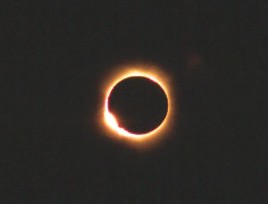 The diamond ring effect at the end of totality, taken near Woomera, South Australia | |
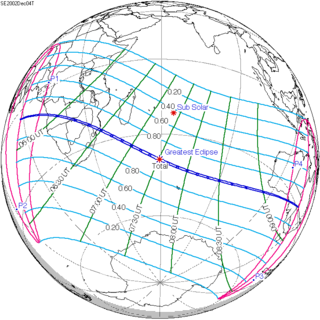 Map | |
| Type of eclipse | |
| Nature | Total |
| Gamma | -0.302 |
| Magnitude | 1.0244 |
| Maximum eclipse | |
| Duration | 124 sec (2 m 4 s) |
| Coordinates | 39°30′S 59°36′E / 39.5°S 59.6°E |
| Max. width of band | 87 km (54 mi) |
| Times (UTC) | |
| Greatest eclipse | 7:32:16 |
| References | |
| Saros | 142 (22 of 72) |
| Catalog # (SE5000) | 9514 |
A total solar eclipse took place on December 4, 2002, with a magnitude of 1.0244. A solar eclipse occurs when the Moon passes between Earth and the Sun, thereby totally or partly obscuring the image of the Sun for a viewer on Earth. A total solar eclipse occurs when the Moon's apparent diameter is larger than the Sun's, blocking all direct sunlight, turning day into darkness. Totality occurs in a narrow path across Earth's surface, with the partial solar eclipse visible over a surrounding region thousands of kilometres wide. It was visible from a narrow corridor in southern Africa, the Indian Ocean and southern Australia. A partial eclipse was seen from the much broader path of the Moon's penumbra, including most of Africa and Australia. During the sunset after the eclipse many observers in Australia saw numerous and unusual forms of a green flash.[1]
In some parts of Angola, it was the second total eclipse of the Sun within 18 months, following the Solar eclipse of June 21, 2001.
Images[]

Related eclipses[]
Eclipses of 2002[]
- A penumbral lunar eclipse on May 26.
- An annular solar eclipse on June 10.
- A penumbral lunar eclipse on June 24.
- A penumbral lunar eclipse on November 20.
- A total solar eclipse on December 4.
Tzolkinex[]
- Preceded: Solar eclipse of October 24, 1995
- Followed: Solar eclipse of January 15, 2010
Half-Saros[]
- Preceded: Lunar eclipse of November 29, 1993
- Followed: Lunar eclipse of December 10, 2011
Tritos[]
- Preceded: Solar eclipse of January 4, 1992
- Followed: Solar eclipse of November 3, 2013
Solar Saros 142[]
- Preceded: Solar eclipse of November 22, 1984
- Followed: Solar eclipse of December 14, 2020
Inex[]
- Preceded: Solar eclipse of December 24, 1973
- Followed: Solar eclipse of November 14, 2031
Solar eclipses 2000–2003[]
This eclipse is a member of a semester series. An eclipse in a semester series of solar eclipses repeats approximately every 177 days and 4 hours (a semester) at alternating nodes of the Moon's orbit.[2]
Note: Partial solar eclipses on February 5, 2000 and July 31, 2000 occur in the previous lunar year set.
| Solar eclipse series sets from 2000–2003 | ||||||
|---|---|---|---|---|---|---|
| Ascending node | Descending node | |||||
| Saros | Map | Gamma | Saros | Map | Gamma | |
| 117 | 2000 July 01 Partial (south) |
-1.28214 | 122 | 2000 December 25 Partial (north) |
1.13669 | |
127 Totality from Lusaka, Zambia |
2001 June 21 Total |
-0.57013 | 132 Partial from Minneapolis, MN |
2001 December 14 Annular |
0.40885 | |
137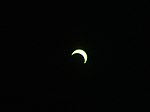 Partial from Los Angeles, CA |
2002 June 10 Annular |
0.19933 | 142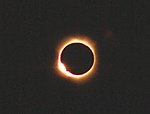 Totality from Woomera |
2002 December 04 Total |
-0.30204 | |
147 Culloden, Scotland |
2003 May 31 Annular |
0.99598 | 152 | 2003 November 23 Total |
-0.96381 | |
Saros 142[]
It is a part of Saros cycle 142, repeating every 18 years, 11 days, containing 72 events. The series started with partial solar eclipse on April 17, 1624. It contains one hybrid eclipse on July 14, 1768, and total eclipses from July 25, 1786 through October 29, 2543. The series ends at member 72 as a partial eclipse on June 5, 2904. The longest duration of totality will be 6 minutes, 34 seconds on May 28, 2291. All eclipses in this series occurs at the Moon’s descending node.[3]
| Series members 17–41 occur between 1901 and 2359 | ||
|---|---|---|
| 17 | 18 | 19 |
 October 10, 1912 |
 October 21, 1930 |
 November 1, 1948 |
| 20 | 21 | 22 |
 November 12, 1966 |
 November 22, 1984 |
 December 4, 2002 |
| 23 | 24 | 25 |
 December 14, 2020 |
 December 26, 2038 |
 January 5, 2057 |
| 26 | 27 | 28 |
 January 16, 2075 |
 January 27, 2093 |
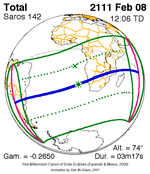 February 8, 2111 |
| 29 | 30 | 31 |
 February 18, 2129 |
 March 2, 2147 |
 March 12, 2165 |
| 32 | 33 | 34 |
 March 23, 2183 |
 April 4, 2201 |
 April 15, 2219 |
| 35 | 36 | 37 |
 April 25, 2237 |
 May 7, 2255 |
 May 17, 2273 |
| 38 | 39 | 40 |
 May 28, 2291 |
 June 9, 2309 |
 June 20, 2327 |
| 41 | ||
 June 30, 2345 | ||
Tritos series[]
This eclipse is a part of a tritos cycle, repeating at alternating nodes every 135 synodic months (≈ 3986.63 days, or 11 years minus 1 month). Their appearance and longitude are irregular due to a lack of synchronization with the anomalistic month (period of perigee), but groupings of 3 tritos cycles (≈ 33 years minus 3 months) come close (≈ 434.044 anomalistic months), so eclipses are similar in these groupings.
| Series members between 1901 and 2100 | |||
|---|---|---|---|
 September 9, 1904 (Saros 133) |
 August 10, 1915 (Saros 134) |
 July 9, 1926 (Saros 135) | |
 June 8, 1937 (Saros 136) |
 May 9, 1948 (Saros 137) |
 April 8, 1959 (Saros 138) | |
 March 7, 1970 (Saros 139) |
 February 4, 1981 (Saros 140) |
 January 4, 1992 (Saros 141) | |
 December 4, 2002 (Saros 142) |
 November 3, 2013 (Saros 143) |
 October 2, 2024 (Saros 144) | |
 September 2, 2035 (Saros 145) |
 August 2, 2046 (Saros 146) |
 July 1, 2057 (Saros 147) | |
 May 31, 2068 (Saros 148) |
 May 1, 2079 (Saros 149) |
 March 31, 2090 (Saros 150) | |
Metonic series[]
The metonic series repeats eclipses every 19 years (6939.69 days), lasting about 5 cycles. Eclipses occur in nearly the same calendar date. In addition, the octon subseries repeats 1/5 of that or every 3.8 years (1387.94 days). All eclipses in this table occur at the Moon's descending node.
| 21 eclipse events, progressing from north to south between July 11, 1953 and July 11, 2029 | ||||
|---|---|---|---|---|
| July 10–12 | April 29–30 | February 15–16 | December 4–5 | September 21–23 |
| 116 | 118 | 120 | 122 | 124 |
 July 11, 1953 |
 April 30, 1957 |
 February 15, 1961 |
 December 4, 1964 |
 September 22, 1968 |
| 126 | 128 | 130 | 132 | 134 |
 July 10, 1972 |
 April 29, 1976 |
 February 16, 1980 |
 December 4, 1983 |
 September 23, 1987 |
| 136 | 138 | 140 | 142 | 144 |
 July 11, 1991 |
 April 29, 1995 |
 February 16, 1999 |
 December 4, 2002 |
 September 22, 2006 |
| 146 | 148 | 150 | 152 | 154 |
 July 11, 2010 |
 April 29, 2014 |
 February 15, 2018 |
 December 4, 2021 |
 September 21, 2025 |
| 156 | 158 | 160 | 162 | 164 |
 July 11, 2029 | ||||
Notes[]
- ^ Maunder, Michael (2007). Lights in the Sky: Identifying and Understanding Astronomical and Meteorological Phenomena. Springer. p. 116. ISBN 1846287618. Retrieved 28 September 2013.
- ^ van Gent, R.H. "Solar- and Lunar-Eclipse Predictions from Antiquity to the Present". A Catalogue of Eclipse Cycles. Utrecht University. Retrieved 6 October 2018.
- ^ http://eclipse.gsfc.nasa.gov/SEsaros/SEsaros142.html
References[]
- Fred Espenak and Jay Anderson. "Total Solar Eclipse of 2002 December 4". NASA, November 2004.
- Earth visibility chart and eclipse statistics Eclipse Predictions by Fred Espenak, NASA/GSFC
- Google Map
Photos:
- Spaceweather.com: Dec. 4, 2002, Solar Eclipse Gallery and [1]
- Prof. Druckmüller's eclipse photography site. Australia
- Prof. Druckmüller's eclipse photography site. South Africa and Mozambique
- KryssTal - Eclipse from Botswana.
- Images from Australia by Crayford Manor House Astronomical Society
- Total Solar Eclipse of 4 December 2002 seen in EUMETSAT satellite imagery.
- Zimbabwe Solar Eclipse, APOD 12/6/2002, Corona from Zimbabwe-South Africa border
- The Crown of the Sun, APOD 12/13/2002, Corona of total eclipse from Musina, South Africa
- Shadow Cone of a Total Solar Eclipse, APOD 1/6/2003, totality from South Australia
| Wikimedia Commons has media related to Solar eclipse of 2002 December 4. |
- Total solar eclipses
- 2002 in science
- 21st-century solar eclipses
- December 2002 events
- 2002 in Angola
- 2002 in Zambia
- 2002 in Zimbabwe
- 2002 in Botswana
- 2002 in Mozambique
- 2002 in South Africa
- 2002 in Australia



